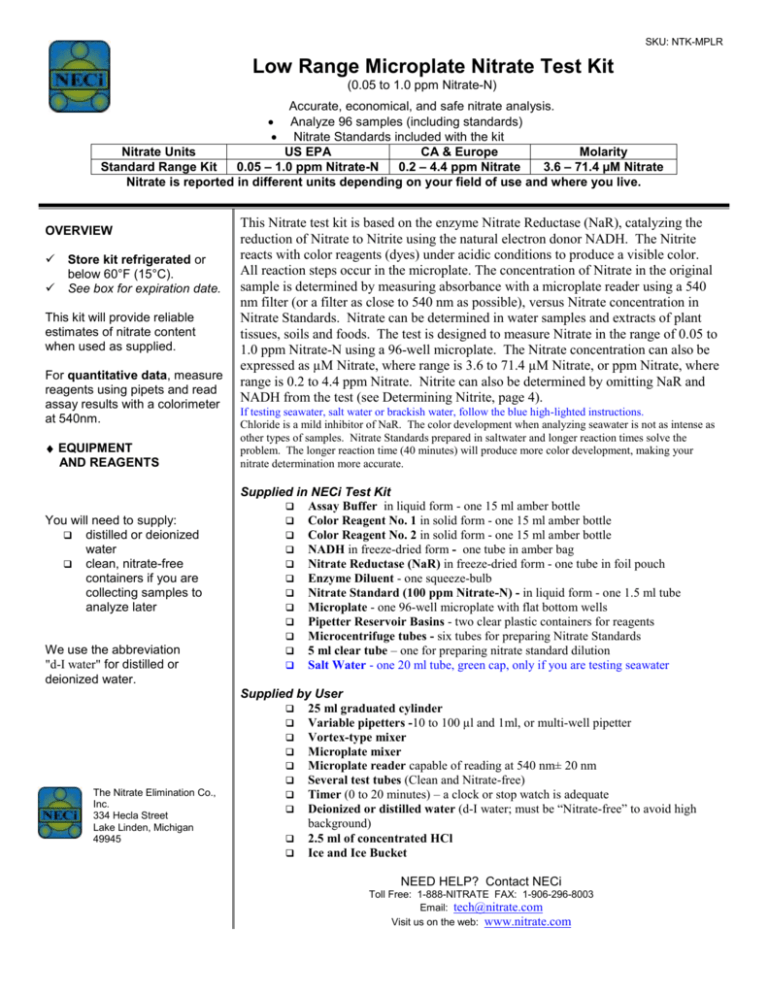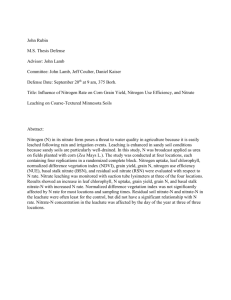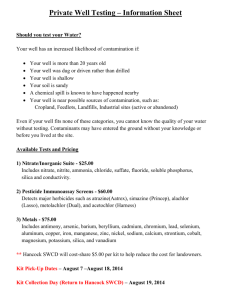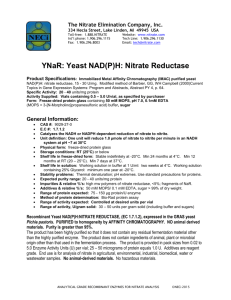
SKU: NTK-MPLR
Low Range Microplate Nitrate Test Kit
(0.05 to 1.0 ppm Nitrate-N)
Accurate, economical, and safe nitrate analysis.
Analyze 96 samples (including standards)
Nitrate Standards included with the kit
Nitrate Units
US EPA
CA & Europe
Molarity
Standard Range Kit
0.05 – 1.0 ppm Nitrate-N
0.2 – 4.4 ppm Nitrate
3.6 – 71.4 µM Nitrate
Nitrate is reported in different units depending on your field of use and where you live.
OVERVIEW
Store kit refrigerated or
below 60°F (15°C).
See box for expiration date.
This kit will provide reliable
estimates of nitrate content
when used as supplied.
For quantitative data, measure
reagents using pipets and read
assay results with a colorimeter
at 540nm.
EQUIPMENT
AND REAGENTS
You will need to supply:
distilled or deionized
water
clean, nitrate-free
containers if you are
collecting samples to
analyze later
We use the abbreviation
"d-I water" for distilled or
deionized water.
The Nitrate Elimination Co.,
Inc.
334 Hecla Street
Lake Linden, Michigan
49945
This Nitrate test kit is based on the enzyme Nitrate Reductase (NaR), catalyzing the
reduction of Nitrate to Nitrite using the natural electron donor NADH. The Nitrite
reacts with color reagents (dyes) under acidic conditions to produce a visible color.
All reaction steps occur in the microplate. The concentration of Nitrate in the original
sample is determined by measuring absorbance with a microplate reader using a 540
nm filter (or a filter as close to 540 nm as possible), versus Nitrate concentration in
Nitrate Standards. Nitrate can be determined in water samples and extracts of plant
tissues, soils and foods. The test is designed to measure Nitrate in the range of 0.05 to
1.0 ppm Nitrate-N using a 96-well microplate. The Nitrate concentration can also be
expressed as µM Nitrate, where range is 3.6 to 71.4 µM Nitrate, or ppm Nitrate, where
range is 0.2 to 4.4 ppm Nitrate. Nitrite can also be determined by omitting NaR and
NADH from the test (see Determining Nitrite, page 4).
If testing seawater, salt water or brackish water, follow the blue high-lighted instructions.
Chloride is a mild inhibitor of NaR. The color development when analyzing seawater is not as intense as
other types of samples. Nitrate Standards prepared in saltwater and longer reaction times solve the
problem. The longer reaction time (40 minutes) will produce more color development, making your
nitrate determination more accurate.
Supplied in NECi Test Kit
Assay Buffer in liquid form - one 15 ml amber bottle
Color Reagent No. 1 in solid form - one 15 ml amber bottle
Color Reagent No. 2 in solid form - one 15 ml amber bottle
NADH in freeze-dried form - one tube in amber bag
Nitrate Reductase (NaR) in freeze-dried form - one tube in foil pouch
Enzyme Diluent - one squeeze-bulb
Nitrate Standard (100 ppm Nitrate-N) - in liquid form - one 1.5 ml tube
Microplate - one 96-well microplate with flat bottom wells
Pipetter Reservoir Basins - two clear plastic containers for reagents
Microcentrifuge tubes - six tubes for preparing Nitrate Standards
5 ml clear tube – one for preparing nitrate standard dilution
Salt Water - one 20 ml tube, green cap, only if you are testing seawater
Supplied by User
25 ml graduated cylinder
Variable pipetters -10 to 100 µl and 1ml, or multi-well pipetter
Vortex-type mixer
Microplate mixer
Microplate reader capable of reading at 540 nm± 20 nm
Several test tubes (Clean and Nitrate-free)
Timer (0 to 20 minutes) – a clock or stop watch is adequate
Deionized or distilled water (d-I water; must be “Nitrate-free” to avoid high
background)
2.5 ml of concentrated HCl
Ice and Ice Bucket
NEED HELP? Contact NECi
Toll Free: 1-888-NITRATE FAX: 1-906-296-8003
Email: tech@nitrate.com
Visit us on the web: www.nitrate.com
Page 2
REAGENT
PREPARATION
NECi Microplate Nitrate Test Kit - Low Range (SKU: NTK-MPLR)
Step 1 Assay Buffer – ready to use from kit. Warm to room temperature for nitrate tests.
If desired, the assay buffer may be more quickly warmed in a 30ºC water bath.
Step 2 Remove NaR vial from foil pouch and tap tube to settle contents before opening.
Twist off the end of the Enzyme Diluent Squeeze Bulb and completely empty the
contents into the NaR vial. Replace the cap and mix by inversion 3 times. Allow
to stand at room temperature for at least 10 minutes, with mixing at 5 and 10
minutes. Then keep on ice during use.
Step 3 Prepare 3 N HCI by adding 2.5 ml concentrated HCl to 7.5 ml d-I water. Mix.
Step 4 Add 10 ml 3 N HCl to Color Reagent No. 1 bottle. Mix by shaking well.
Step 5 Add 10 ml d-I water to Color Reagent No. 2 bottle. Mix by shaking well.
Step 6 Remove tube of NADH from amber bag, tap tube to settle contents, add 1.5 ml
d-I water and replace cap. Mix by inversion several times. Keep on ice until
use.
Step 7 In pipetter reservoir basin (included in kit), add 9 ml Assay Buffer, 1 ml NaR
solution (prepared in Step 2), and 0.5 ml NADH solution (prepared in Step 6).
Mix thoroughly. Note: this step should be done just prior to use in Step 3 of the
Nitrate Assay Procedure.
NOTES ON THE
REAGENTS
************************
STANDARD
PREPARATION
Assay Buffer - 25 mM KH2PO4, 0.025 mM EDTA; pH 7.5
Color Reagent No. 1 - 1% Sulfanilamide in 3N HCI
Color Reagent No. 2 - 0.02% N-Naphthylethylenediamine in d-I water
NADH – 2.4 mg NADH
Nitrate Reductase (NaR) – 1.0 unit of NaR per tube
Nitrate Standard – 1 vial of 100 ppm nitrate-N
Salt Water - may contain 0.05 ppm nitrate-N, giving your blank a slight pink color
****************************************************************************
Transfer 0.5 ml of 100 ppm nitrate standard (provided in kit) to a test tube. Dilute with
4.5 ml of d-I water to make a 10 ppm nitrate standard. In the 5 ml clear tube (provided
in kit), dilute 0.5 ml of the 10 ppm standard with 4.5 ml of d-I water to make a 1 ppm
nitrate standard. Use this 1 ppm standard and the 6 microtubes to prepare nitrate
standards as shown in the table below. If you are testing seawater, use the Salt Water
provided instead of d-I water to prepare standards.
The Nitrate Elimination Co., Inc.
334 Hecla Street
Lake Linden, Michigan 49945
Vol 1 ppm
Nitrate-N
Standard
1000
500
250
125
50
0
Volume
d-I water
0
500
750
875
950
1000
Resulting
Standard
(ppm Nitrate-N)
1.0
0.5
0.25
0.125
0.05
0
Resulting
Standard
(ppm Nitrate)
4.4
2.2
1.1
0.55
0.22
0
Resulting
Standard
(µM)
7.14
35.7
17.9
8.9
3.6
0
Page 3
NECi Microplate Nitrate Test Kit - Low Range (SKU: NTK-MPLR)
NITRATE ASSAY
PROCEDURE
Using the Microplate Sample Template, assign and record a set of 2 wells for each Nitrate
Standard, Sample and Reagent Blanks.
STEP 1 Pipette 50 µl d-I water into 2 wells for reagent blanks. If testing seawater, use the Salt
Water provided instead of d-I water.
o
The following
procedure is written
for 2 replicates of
each standard,
unknown sample
and reagent blank.
STEP 2 Pipette 50 µl of the standards and samples into designated wells.
STEP 3 Add 50 µl NaR-Assay Buffer-NADH solution (prepared in Step 7 of Reagent
Preparation) to each well. Shake on a plate mixer for ~ 20 minutes @ 800 rpm. If
testing seawater, shake for ~40 minutes @ 800 rpm.
STEP 44If using a multi-pipetter, rinse the pipetter reservoir basins with d-I water. Transfer
Color Reagent No. 1 to one basin and Color Reagent No. 2 solution to the other basin.
WASTE DISPOSAL
Follow all local guidelines
and regulations. If there are
no local guidelines, wash the
waste down the sink with
large amounts of running
water.
STEP 5 Add 50 µl Color Reagent No. 1 and 50µl Color Reagent No. 2 solution to each well.
Shake on a plate mixer for ~ 10 minutes @ 800 rpm.
STEP 6 Zero the plate reader with a Reagent Blank well using a 540 nm filter (or a filter
within 20 nm of 540 nm).
STEP 7 Read absorbance of all wells. Transfer results to your computer system for analysis
and printing.
************************
CALCULATIONS
******************************************************************************
STEP 1 To correct for any background absorbance due to the reagents, subtract the
mean absorbance of the reagent blanks from the mean absorbance of each
nitrate standard and unknown sample:
Corrected mean sample A-540 nm = (mean A-540 nm for samples) – (mean A-540 nm for reagent blank)
STEP 2 Generate a standard curve for the Nitrate Standard (see example below).
Using linear graph paper or a computer plotting program such as Sigma
Plot® or spreadsheet such as Excel®, plot the ppm Nitrate-N on the x-axis, and
the A-540 nm for each nitrate standard on the y-axis. If plotting by hand, draw
a straight line through the points for the Nitrate Standards. If plotting by
computer, the slope of the line can be calculated for determining Nitrate-N ppm
in the unknown samples.
STEP 3 Using the standard curve, determine the ppm Nitrate-N for the sample: (a) Find
the corrected A-540 nm for the sample on the y-axis of the standard curve. (b)
Follow over along a horizontal line to where the line intersects the standard
curve. Trace down the x-axis and read the ppm of Nitrate-N on the x-axis.
Typical Standard Curve for NECi Low Range
M-NTK
The Nitrate Elimination Co., Inc.
334 Hecla Street
Lake Linden, Michigan 49945
Absorbance at 540 nm
0.5
slope = 0.43 A-540 nm/ppm Nitrate-N
0.4
0.3
Unknown Sample Absorbance
0.2
Unknown
Sample
Concentration
0.1
0
0
0.2
0.4
0.6
ppm Nitrate-N
0.8
1
Page 4
UNKNOWN
SAMPLES WITH
HIGH NITRATE
NECi Microplate Nitrate Test Kit - Low Range (Catalog No. M-NTK-302)
This NECi Nitrate Test Kit is capable of determining Nitrate levels of up to 1.0 ppm Nitrate-N
(4.4 ppm Nitrate or 71 µM Nitrate). If an unknown sample is found to have more than 1.0 ppm
Nitrate-N, the sample may be diluted with d-I water 1:10 to allow an exact determination. For
example, take 100 µl of sample and add 900 µl of deionized water to make a 1:10 dilution and
then assay 50 µl of the diluted sample. After finding the Nitrate content of the diluted sample,
multiply the Nitrate concentration by 10 to find the Nitrate concentration in the original sample.
NOTE: Keep the sample volume constant by diluting the sample rather than using a smaller
volume of sample in the assay.
*******************
************************************************************************************
DETERMINING
NITRATE IN
MOLAR UNITS
Use a conversion of 1ppm Nitrate-N = 71 µM Nitrate. One ppm Nitrate-N = 1 mg of
Nitrogen/liter. Since Nitrogen has a molecular weight of 14 g/mole, then the molar
concentration is:
(0.001 g/1) ÷ (14 g/mole) = 0.000071 M Nitrogen =
0.000071 M Nitrate = 71 µM Nitrate
*******************
************************************************************************************
DETERMINING
NITRATE AS A
QUANTITY
(Using the 50 µl Sample Size). In the wells where the 1.0 ppm nitrate-N standard is
determined, there is approx. 3.6 nmol of Nitrate [(71 nmol Nitrate/ml) x (0.05 ml) =
3.55 nmol]. So the example standard curve would have a slope of 0.119 A-540
nm/nmol Nitrate (calculated from slope = 0.43A-540 nm/3.6 nmol Nitrate).
********************
************************************************************************************
NITRATE
DETERMINATION
IN PLANT LEAF
EXTRACTS
To determine how much Nitrate is in one gram of leaf tissue, grind the tissue in 10 ml d-I water
and measure the total volume of extract after the solids are filtered off. Take 50 µl of extract
for the Nitrate assay, conduct the Nitrate Test Kit assay and find the amount of Nitrate present
in nmoles. Determine the total amount of Nitrate in the extract [= (total volume of extract) x
(nmol Nitrate/50 µl of extract)]. Divide this total amount of Nitrate by the weight of plant
tissue to find the amount of Nitrate per unit of tissue (grams in this example). The green or
brown color of the leaf extract does not significantly interfere with Nitrate determinations since
the plant extract is diluted 4-fold in the assay. The most quantitative analysis of leaf Nitrate
content is obtained when the leaves are boiled for 20 min. After boiling, cool on ice and then
filter the sample to recover aqueous extract. Finally, make the volume back up to 10 ml to
compensate for water lost during boiling. Ask NECi for a detailed protocol for extracting
either fresh plant leaves or dried leaf material for Nitrate Assays.
******************
*****************************************************************************
Determining
Nitrite
Nitrite can be determined by omitting NaR and NADH from the samples. Replace the solution
in Step 3 of the Nitrate Assay Procedure with 50 µl of d-I water and eliminate Step 4. Prepare
Nitrate standards as described in the normal Nitrate Assay Procedure with both NADH and
NaR added and use the Nitrate Standard Curve for estimating Nitrite content.
******************
*****************************************************************************
The Clean Water and Safe Drinking Water Acts (U.S. EPA 1974) set Maximum Contaminant
Level (MCL) for portable water at 10 ppm Nitrate-N (10 mg Nitrate-N per liter). California and
European standards are 45 ppm nitrate (45 mg nitrate per liter). If you find drinking water with
7 to 10 ppm Nitrate-N or more, advise users to seek a professional test of their water.
Environmental water samples usually contain 1 to 2 ppm Nitrate-N or less.
Notes on Nitrate
in Water
Thanks for using our products. Call Tech Support: 1.906.296.1130, or visit the NECi website: www.nitrate.com if you need more information. We’re
always interested in hearing about your experience with our kits.
NECi, The Nitrate Elimination Co., Inc.: Biotechnology People Can Use!
Copyright © 2015 The Nitrate Elimination Co., Inc. (NECi); All rights reserved.








